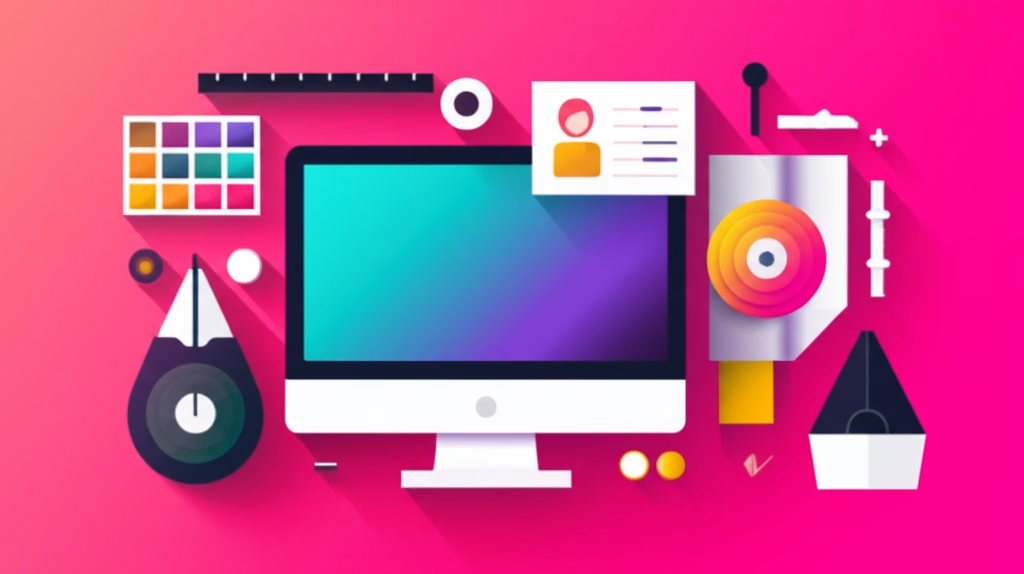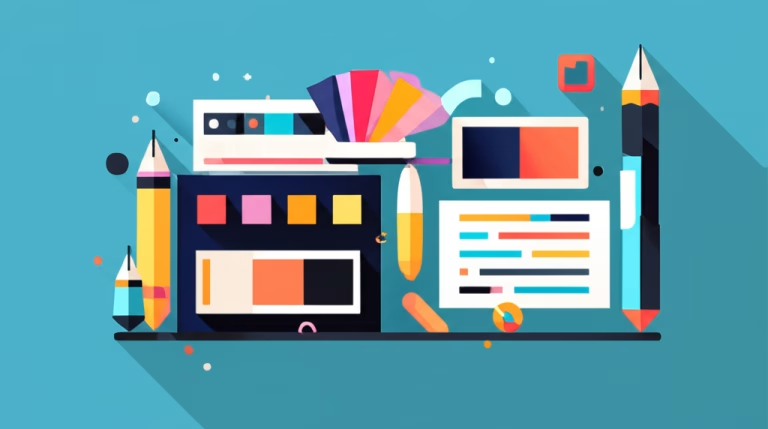Sharpen Your Gaze: How Visual Discovery Transforms Your Designs
Ever feel like you’re looking, but not truly seeing? As a beginner in graphic design, web design, visual identity, or social media, it’s easy to feel overwhelmed by the sheer volume of visual content out there. You might scroll through endless feeds, admiring beautiful work, yet struggle to pinpoint *why* something resonates or how to apply that insight to your own projects. This isn’t about a lack of talent; it’s about developing your Visual Discovery skills – the art of actively observing, analyzing, and interpreting the world around you to fuel your creative output.
Conscious Visual Discovery isn’t just a passive activity; it’s a powerful practice that directly impacts your ability to generate original ideas and elevate your designs. By training your eye to see beyond the surface, you unlock a richer well of inspiration, allowing you to move from simply imitating trends to understanding their underlying principles and innovating. This article will guide you through simple yet profound ways to sharpen your observational skills and transform how you approach every visual challenge, ensuring your creative vision is always fresh and impactful.
Table of Contents
The Power of a Trained Eye in Design
What does it mean to have a “trained eye” in design? It means actively engaging with the visual world, not just passively consuming it. It’s about developing your Observational Skills to notice details, patterns, and relationships that others might miss. This deeper level of perception is crucial because every element in design – a color, a typeface, a shape, a composition – carries meaning and evokes emotion. When you truly see, you begin to understand the language of visuals, allowing you to speak it fluently in your own work.
Consider iconic designs throughout history. Many were born not from a sudden flash of genius, but from a designer’s keen observation of nature, architecture, or everyday objects. Think of the simplicity of the Apple logo, drawing on a universal symbol with a playful twist. Or the elegant lines of Bauhaus design, inspired by functional architecture. These aren’t just pretty pictures; they are products of a highly developed Creative Vision, a result of designers who trained themselves to truly *see* the world and translate its essence into impactful visuals. For instance, the minimalist aesthetic often seen in modern web design is influenced by a long history of art movements prioritizing clarity and function, like De Stijl or Swiss Style, which designers discovered through active visual research and analysis.
How to Cultivate Your Visual Discovery Habits
Developing your Visual Discovery is a continuous journey, much like honing any other skill. It requires intention and consistent practice. Here’s how you can start to integrate it into your daily routine:
Observe with Intention: Beyond Just Looking
The first step is to shift from passive viewing to active observation. Pick an object, a scene, or even a piece of existing design and truly *study* it. Don’t just glance. Ask yourself:
- What colors are present, and what are their nuances?
- What shapes dominate? Are they organic or geometric?
- How is light interacting with the surfaces?
- What textures can you identify?
- What is the overall mood or feeling evoked?
- How are the elements arranged? Is there a clear focal point?
This intentional observation builds your Aesthetic Perception, allowing you to deconstruct and understand visual information on a deeper level. Try this exercise: spend five minutes observing a single object, like a coffee cup or a plant, and list every visual detail you can.
Build Your Visual Library: The Art of Inspiration Hunting
Your brain is a powerful database. The more diverse visual inputs you feed it, the richer your internal library becomes. Actively seek out inspiration from varied sources, not just other design portfolios. Explore art history, photography, fashion, architecture, nature, and even everyday objects like product packaging or street signage. Every visual element you encounter can be a potential seed for a new idea. Create digital or physical “swipe files” or mood boards to collect these visual treasures. This practice is a form of active Visual Discovery, constantly enriching your creative palette. For more on organizing these visuals, check out our article on References and Moodboards.
Deconstruct and Reconstruct: Learning from the Masters
When you encounter a design that impresses you, don’t just admire it. Deconstruct it. What specific elements (colors, fonts, layout, imagery) contribute to its impact? How do they work together? Then, try to reconstruct it in your mind, or even physically, using different elements. For example, if you love the color palette of a painting, try applying those colors to a web layout. This exercise in AIGA’s resources on design principles can help you understand the core mechanics of effective design. This active process of analysis and synthesis sharpens your ability to discern effective visual strategies and apply them to new contexts.
Applying Visual Discovery to Your Projects
Once you’ve started training your eye, how do you translate that into practical design improvements?
From Observation to Idea Generation
Let your observations inform your brainstorming. If you’ve been studying the dynamic lines of a city skyline, how can that influence the layout of a social media graphic? If you’ve noticed a fascinating color combination in nature, can it inspire your next brand identity palette? Visual Discovery isn’t just about finding pretty things; it’s about seeing how elements interact and applying those principles to your specific design challenges. This helps foster genuine Creative Vision, allowing you to solve problems uniquely.
Experiment with New Styles and Applications
Don’t be afraid to step outside your comfort zone. If your eye is drawn to vintage aesthetics, try incorporating subtle retro elements into a modern design. If you’re fascinated by abstract art, explore how abstract shapes can communicate ideas in a logo. The more you experiment with different styles and how they can be applied, the more versatile your creative repertoire becomes. This continuous exploration prevents stagnation and keeps your Visual Discovery process exciting.
Embrace Visual Storytelling
Every design tells a story. By sharpening your eye, you become better at understanding and crafting these narratives. How can your chosen imagery, typography, and colors convey a specific message or emotion? For example, a website with soft, natural textures and a harmonious color palette tells a story of calm and organic growth, discovered through observing similar qualities in natural environments. Practice creating mood boards that tell a story, even before you start designing a single element.
Overcoming Obstacles in Visual Discovery
Even with the best intentions, you might face challenges in consistently practicing Visual Discovery. Recognizing these can help you overcome them:
- Mental Obstacle: The “I Don’t See Anything Interesting” Mindset
Sometimes, we feel that our immediate surroundings lack inspiration. This is a common block where our brain filters out the “mundane.”
How to Overcome: Challenge yourself to find beauty in the ordinary. Look at everyday objects from new angles, in different lighting, or focus on a single detail. The goal is to consciously override your brain’s filtering mechanism. Try a “visual scavenger hunt” in your neighborhood, looking for specific colors or textures. - Technical Obstacle: Over-Reliance on Digital Tools
Many beginners jump straight into software, neglecting real-world observation. This can lead to uninspired or generic designs.
How to Overcome: Dedicate time each day to unplug. Carry a small sketchbook or just use your phone camera to capture visual notes from the physical world. Interact with textures, light, and shadows directly. This physical engagement enriches your Aesthetic Perception in a way screens cannot. - Resource Obstacle: Feeling Limited by Lack of “Grand” Inspiration Sources
You might think you need to visit museums or exotic locations to find inspiration, which isn’t always feasible.
How to Overcome: Realize that the richest sources of Visual Discovery are often right in front of you. Your local park, a bustling market, even your own home, are filled with visual cues. The key is your *approach* to these everyday environments. Look for patterns in brickwork, the interplay of light and shadow on a wall, or the typography on a cereal box.
Your Journey to a More Creative Eye
Embracing Visual Discovery is a transformative step for any aspiring designer. It shifts your perspective from passively receiving information to actively engaging with and interpreting the visual world. This journey is continuous, and every observation, every analysis, and every new idea you cultivate strengthens your creative muscle.
Beginner Level (0-3 months)
Focus on simple observation exercises. Spend 5-10 minutes daily truly *seeing* one object or scene. Take mental notes or quick photos. Try to identify primary colors, shapes, and textures. The goal is to build awareness and begin training your Observational Skills.
Intermediate Level (3-12 months)
Start connecting observations to design principles. How does the balance you observed in architecture apply to a poster layout? Experiment with applying a color palette from nature to a digital design. Begin building simple mood boards from your visual discoveries, linking them to potential projects. This stage is about translating raw observation into actionable design insights and refining your Aesthetic Perception.
Advanced Level (1+ years)
At this stage, Visual Discovery becomes an intuitive part of your workflow. You’re constantly absorbing and analyzing, using the world as your boundless source of inspiration. Challenge yourself to find inspiration in unconventional places and to develop unique Creative Vision that sets your work apart. You’ll not only see the world differently but also understand how to weave its visual stories into compelling designs.
Conclusion: See More, Create More
Your journey into design is deeply intertwined with your ability to see. By consciously practicing Visual Discovery, you’re not just improving your designs; you’re enriching your entire perception of the world. Embrace the curiosity, challenge yourself to look deeper, and allow every visual encounter to spark new ideas and possibilities. The world is a canvas of endless inspiration, waiting for your trained eye to uncover its secrets and translate them into truly remarkable designs. Start seeing, and start creating with newfound clarity and purpose.
Recommended Reading:
– References and Moodboards – Learn how to organize your visual discoveries and create effective mood boards to guide your design projects.



